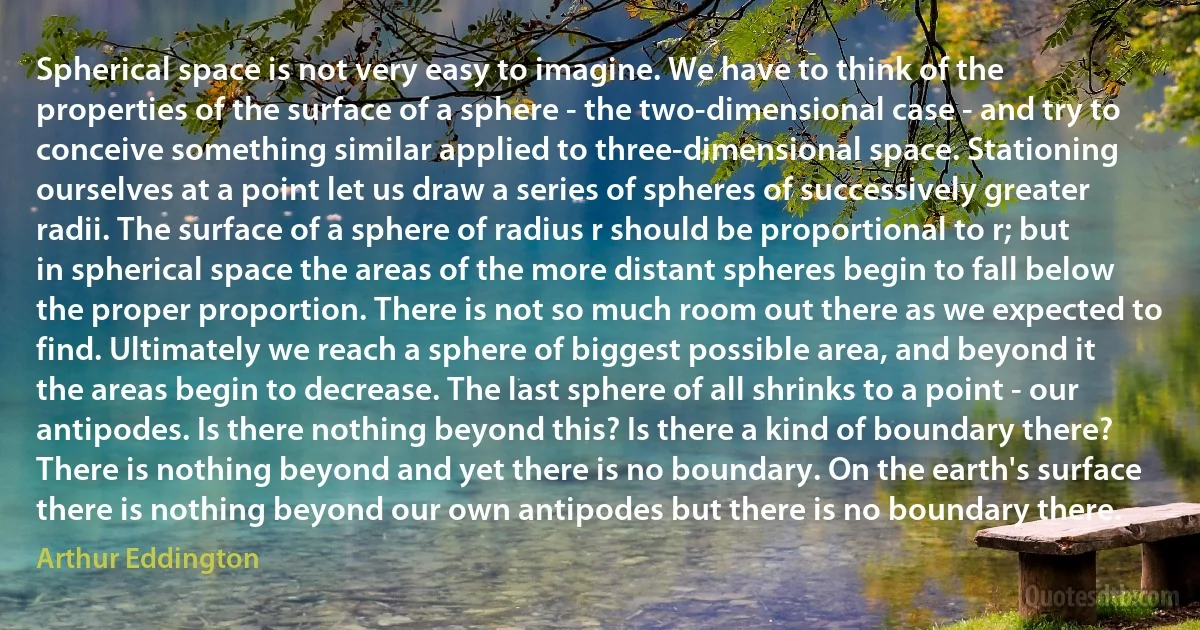
Spherical space is not very easy to imagine. We have to think of the properties of the surface of a sphere - the two-dimensional case - and try to conceive something similar applied to three-dimensional space. Stationing ourselves at a point let us draw a series of spheres of successively greater radii. The surface of a sphere of radius r should be proportional to r; but in spherical space the areas of the more distant spheres begin to fall below the proper proportion. There is not so much room out there as we expected to find. Ultimately we reach a sphere of biggest possible area, and beyond it the areas begin to decrease. The last sphere of all shrinks to a point - our antipodes. Is there nothing beyond this? Is there a kind of boundary there? There is nothing beyond and yet there is no boundary. On the earth's surface there is nothing beyond our own antipodes but there is no boundary there.
Arthur EddingtonRelated topics
antipodes begin beyond case draw easy fall find kind last nothing point possible proper proportional radius reach room series should something space surface think try yetRelated quotes
Thoughts have some characteristics of fancy, of freedom, even of unreality, which are wanting to the prosaicness of heavy material things. Thoughts sport with the relations of time and space; they fly in a moment across the gulf between the most distant objects; they travel back up the course of time; they bring near to us events centuries away; they conceive objects which are unreal; they imagine combinations which upset all physical laws, and, further, these conceptions remain invisible to others as well as to ourselves. They are outside the grip of reality, and constitute a world which becomes, for any one with the smallest imagination, as great and as important as the world called real. One may call in evidence the poets, novelists, artists, and the dreamers of all kinds. When life becomes too hard for us, we fly to the ideal world, there to seek forgetfulness or compensation.

Alfred Binet
I do not mean to say that formal economic analysis is worthless, and that anybody's opinion on economic matters is as good as anyone else's. On the contrary! I am a strong believer in the importance of models, which are to our minds what spear-throwers were to stone age arms: they greatly extend the power and range of our insight. In particular, I have no sympathy for those people who criticize the unrealistic simplifications of model-builders, and imagine that they achieve greater sophistication by avoiding stating their assumptions clearly. The point is to realize that economic models are metaphors, not truth. By all means express your thoughts in models, as pretty as possible (more on that below). But always remember that you may have gotten the metaphor wrong, and that someone else with a different metaphor may be seeing something that you are missing.

Paul Krugman
In the spring of 1951 Churchman and I accepted appointments to (then) Case Institute of Technology in Cleveland because Case was committed to establishing an activity in Operations Research and Churchman and I had come to believe we could probably work better under this name than under the cloak of academic philosophy. By the end of 1952 we had formal approval, but not without faculty opposition, for the first doctoral program in Operations Research. From then on the Group and the program grew rapidly and flourished. Case became a mecca to which pilgrimages of operations researchers from around the world came. In 1958, Churchman, for personal reasons, migrated to the University of California at Berkeley where he established a similar activity. Academic Operations Research activities began to proliferate and flourish, many of them modeled on those at Case.

Russell L. Ackoff
It is not true, out of geometry, that the mathematical sciences are, in all their parts those models of finished accuracy which many suppose. The extreme boundaries of analysis have always been as imperfectly understood as the tract beyond the boundaries was absolutely unknown. But the way to enlarge the settled country has not been by keeping within it, but by making voyages of discovery, and I am perfectly convinced that the student should be exercised in this manner; that is, that he should be taught how to examine the boundary, as well as how to cultivate the interior. ...allowing all students whose capacity will let them read on the higher branches of applied mathematics, to have each his chance of being led to the cultivation of those parts of analysis on which rather depends its future progress than its present use in the sciences of matter.

Augustus De Morgan
What, then, is the animal? First of all, a system of plant-souls. The unity of those plant-souls, which unity nature itself produces, is the soul of the animal. Its world is therefore partly that of the plants - its nourishment, for instance, it receives partly through synthesis from vegetable, and through analysis from animal nature - and partly that of the animals, whereof we shall speak directly. Each product of nature is an organically in-itself completed totality in space, like the plant. Hence, the unknown x which we are looking for must also be such a whole or totality, and in so far it must also have a principle of organization, a sphere and central point of this organization; in short, the same which we have called the soul of the plant, which thus remains common to both. ... The animal is a system of plant-souls, and the plant is a separated, isolated part of an animal. Both reciprocally affect each other.

Johann Gottlieb Fichte
